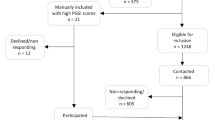Abstract
The purpose of this study is to describe the physiological responses occurring during slot gambling in 23 females with problematic and non-problematic gambling backgrounds in two sites: at a casino using their own money and at a casino laboratory without wagering money. Using the National Opinion Research Center Diagnostic Screen (NODS), 12 women were not-at-risk gamblers and 11 were at-risk, problem, or pathological gamblers. Blood pressure (BP), heart rate (HR), respiratory rate (RR), skin conductance (SC), and skin temperature (ST) were measured for 5 min before gambling (baseline), 10 min while gambling, and 5 min after gambling (recovery). In the casino, SBP (p = .001), DBP (p = .031), HR (p = .030), and RR (p = 004) rose during gambling and fell during recovery; ST rose throughout the study (p = .006). There were no differences between subjects based on NODS score. A total of 12 subjects were also studied in the laboratory. SBP (p = .004), DBP (p = .000); HR (p = .023); RR (p = .000) and SC (p = .002) rose during gambling and fell during recovery; ST rose throughout the study (p = .006). There were no significant differences by location. The observed effects suggest that females find slot play physiologically arousing, with or without financial stakes, because physiological changes were consistent with an arousal response.
Similar content being viewed by others
References
Arriaga, P., Esteves, F., Carneiro, P., & Monteiro, M. B. (2006). Violent computer games and their effects of state hostility and physiological arousal. Aggressive Behavior, 32, 146–158.
Blanchard, E. B., Wulfert, E., Freidenberg, B. M., & Malta, L. S. (2000). Psychophysiological assessment of compulsive gamblers’ arousal to gambling cues: A pilot study. Applied Psychophysiology and Biofeedback, 25(3), 155–165.
Coventry, K. R., & Constable, B. (1999). Physiological arousal and sensation-seeking in female fruit machine gamblers. Addiction, 94, 425–430.
Coventry, K. R., & Hudson, J. (2001). Gender differences, physiological arousal and the role of winning in fruit machine gamblers. Addiction, 96, 871–879.
Dannon, P. N., Lowengrub, K., Aizer, A., & Kotler, M. (2006). Pathological gambling: comorbid psychiatric diagnoses in patients and their families. The Israel journal of psychiatry and related sciences, 43(2), 88–92.
Gerstein, D., Hoffmann, J., Larison, C. et al. (1999). Gambling impact and behavior study. National Opinion Research Center, University of Chicago. http://www.norc.uchicago.edu/new/gamb-fin.htm. Accessed 4/17/06.
Goudriaan, A. E., Oosterlaan, J., de Beurs, E., & den Brink, W. (2004). Pathological gambling: a comprehensive review of biobehavioral findings. Neuroscience Biobehavior Review, 28(2), 123–141.
Grant, J. E., & Kim, S. W. (2006). Medication management of pathological gambling. Minnesota Medicine, 89(9), 44–48.
Grant, J. E., Potenza, M. N., Hollander, E., Cunningham-Williams, R., Nurminen, T., Smits, G., & Kallio A. (2006). Multicenter investigation of the opioid antagonist nalmefene in the treatment of pathological gambling. American Journal of Psychiatry, 163(2), 303–312.
Jason, D. R., Taff, M. L., & Boglioli, L. R. (1990). Casino-related deaths in Atlantic City, New Jersey 1982–1986. American Journal of Forensic Medicine and Pathology, 11(2), 112–123.
Kapuku, G. K., Treiber, F. A., & Davis, H. C. (2002). Relationships among socioeconomic status, stress induced changes in cortisol, and blood pressure in African American males. Annals of Behavioral Medicine, 24(4), 320–325.
Krueger, T. H. C., Schedlowski, M., & Meyer, G. (2005). Cortisol and heart rate measures during casino gambling in relation to impulsivity. Neuropsychobiology, 52, 206–211.
Leary, K., & Dickerson, M. (1985). Levels of arousal in high-and low-frequency gamblers. Behaviour Research and Therapy, 23, 635–645.
Meyer G., Hauffa, B. P., Schedlowski, M., Pawlak, C., Stadler, M. A., Exton, M. S. (2000). Casino gambling increases heart rate and salivary cortisol in regular gamblers. Biological Psychiatry, 48(9), 948–953.
Meyer G., Schwertfeger, J., Exton, M. S., Janssen, O. E., Knapp, W., Stadler, M. A., Schedlowski, M., & Kruger, T. H. C. (2004). Neuroendocrine response to casino gambling in problem gamblers. Psychoneuroendocrinology, 29, 1272–1280.
Moodie, C., & Finnigan, F. (2005). A comparison of the autonomic arousal of frequent, infrequent, and non-gamblers while playing fruit machines. Addiction, 100, 51–59.
Petry, N. M., Stinson, F. S., & Grant, B. F. (2005). Co-morbidity of DSM-IV pathological gambling and other psychiatric disorders: results from the national epidemiologic survey on alcohol and related conditions. Journal of Clin ical Psychiatry, 66(5), 564–574.
Potenza, M. N., Fiellin, D. A., Heninger, G. R., Rounsaville, B. J., & Mazure, C. M. (2002). Gambling: an addictive behavior with health and primary care implications. Journal of General Internal Medicine, 17(9), 721–732.
Sharpe, L. (2004). Patterns of autonomic arousal in imaginal situations of winning and losing in problem gambling. Journal of Gambling Studies, 20(1), 95–104.
Spielberger, C. D., Gorsuch, R. L., & Luchene, R. E. (1970). STAI manual for the state-trait anxiety inventory. Palo Alto: Consulting Psychologists Press.
Treiber, F. A., Kapuku, G. K., Davis, H., Pollock, J. S., & Pollock, D. M. (2002). Plasma endothelin-1 release during acute stress: role of ethnicity and sex. Psychosomatic Medicine, 64, 707–713.
Wallston, K. A., & Wallston, B. S. (1978). Development of the multidimensional health locus of control (MHLC) scales. Health Education Monographs, 6(2), 160–170.
Acknowledgements
We wish to thank Greg and Cliff Lee for their devotion to this project. This study was funded by a grant from the UNLV School of Nursing Center of Excellence in Women’s Health, U.S. Department of Education.
Author information
Authors and Affiliations
Corresponding author
Rights and permissions
About this article
Cite this article
Yucha, C., Bernhard, B. & Prato, C. Physiological Effects of Slot Play in Women. Appl Psychophysiol Biofeedback 32, 141–147 (2007). https://doi.org/10.1007/s10484-007-9040-z
Published:
Issue Date:
DOI: https://doi.org/10.1007/s10484-007-9040-z



